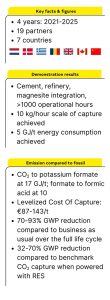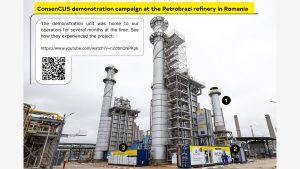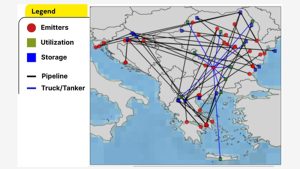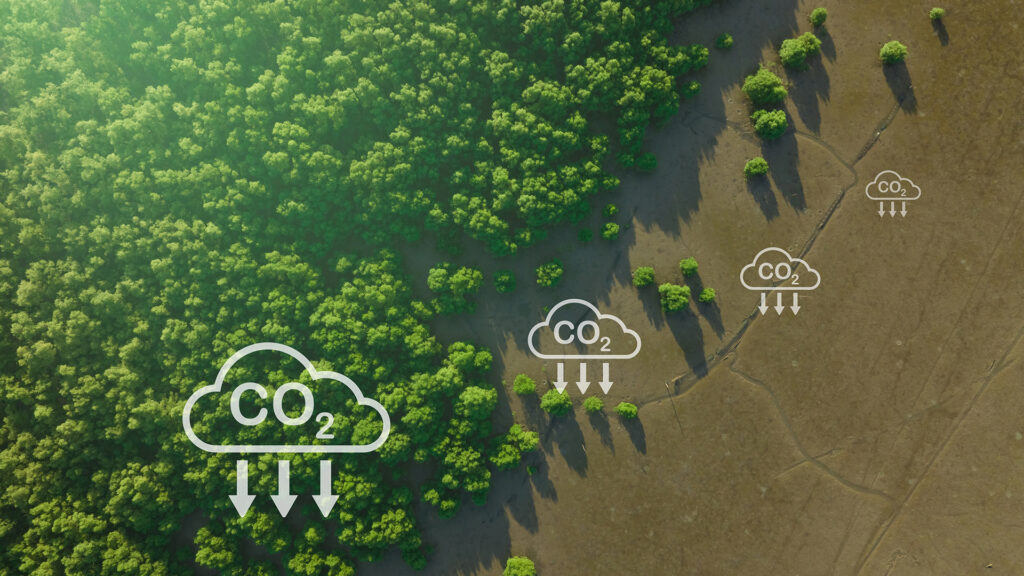Learnings from the multidisciplinary ConsenCUS innovation project and how it enables a sustainable future.
To prevent dramatic climate change, we need to avoid emissions of greenhouse gases such as carbon dioxide into the atmosphere. In fact, Europe is leading the way with the goal of net zero emissions, or complete climate neutrality by 2050. Achieving these goals requires capturing CO2 from industrial processes (or air) and then utilizing or storing this gas (CCU/S). However, CCU/S itself has significant energy costs, so this process not only needs to be accelerated in terms of adoption, but also made more sustainable to achieve net-zero industrial emissions.
ConsenCUS project
 Since 2021, a consortium of 19 industry and academic partners has been working on breakthrough innovations aimed at making CCUS compatible with a net-zero world. The core strategy revolves around using electricity for capture and conversion processes, which is much easier to decarbonize than heat-based solutions on the market. In a nutshell, the ConsenCUS project aimed to achieve its acronym: “Carbon-neutral clusters through electricity-based innovations in capture, utilization and storage.” The project is now in its final months. A three-stage pilot campaign demonstrated the technical feasibility of the solution, and multidisciplinary analysis demonstrated the potential economic, environmental and social impacts of the innovation if it were fully implemented.
Since 2021, a consortium of 19 industry and academic partners has been working on breakthrough innovations aimed at making CCUS compatible with a net-zero world. The core strategy revolves around using electricity for capture and conversion processes, which is much easier to decarbonize than heat-based solutions on the market. In a nutshell, the ConsenCUS project aimed to achieve its acronym: “Carbon-neutral clusters through electricity-based innovations in capture, utilization and storage.” The project is now in its final months. A three-stage pilot campaign demonstrated the technical feasibility of the solution, and multidisciplinary analysis demonstrated the potential economic, environmental and social impacts of the innovation if it were fully implemented.
Demonstration of carbon capture and utilization
ConsenCUS carbon capture technology takes advantage of the natural equilibrium between CO2 and water. At high pH, the potassium hydroxide solution absorbs CO2 directly from the factory exhaust gas passing through the absorption column. A separate regeneration module uses an electrochemically active membrane stack to lower the pH and bubble out the CO2 to recycle the solvent into the absorption process.
The central challenge of this project was to bring this previously unproven concept for carbon capture from laboratory scale to a real industrial environment. After careful design and construction, the demonstration module was proven capable of dealing with completely different exhaust gas compositions on-site at a cement production plant in Aalborg (Denmark), a refinery near Ploiesti (Romania) and a magnesite production plant in Jerakini (Greece). The main challenges addressed are achieving low energy consumption and high CO2 capture efficiency, making the technology competitive with benchmark technologies when applied at full scale.
The captured CO2 was used to feed an adjacent CO2 utilization module, which also used electricity to pressurize the CO2 and convert it into potassium formate. This biodegradable product is a preservative with a multi-billion dollar market, but to further increase its value, it can also be used to make formic acid and to make proteins and fuels. It turns out that even at this pilot scale, the process uses less energy than the traditional fossil route for producing potassium formate and formic acid, and could be fully sustainable using renewable electricity.

As shown in the diagram, the capture process consists of:
1. CO2 absorption tower;
2. Solvent regeneration and CO2 separation module; and
3. CO2 utilization module introduced to convert CO2 into useful chemical building blocks.
Net-zero industry requires safe CO2 pipelines and storage
Even if carbon capture and utilization technologies are fully developed and decarbonized, achieving a net-zero industry will require moving carbon to the optimal location for conversion or storage. The results of the ConsenCUS project contribute to three important assumptions:
Safety assessment of permanent underground CO2 storage sites (e.g. Stenril in Denmark) and gas quality and geological characteristics of temporary underground CO2 storage during multiple loading and unloading sequences, which may be relevant in the future. Risk assessment of CO2 pipeline transportation, especially regarding rupture in different weather conditions. A mathematical model for optimizing CO2 logistics between emitters and users or storage locations. Applied to a case study of sustainable aviation fuel production and South-Eastern Europe as a net-zero industry cluster.
people and the earth
ConsenCUS’ field research through online conferences, town hall meetings, and visits to schools and community centers provided insight into the level of awareness and acceptance of CCU/S among the general public. We found that public awareness of CCU/S technology is low, and the acceptance of CCU/S depends on a high degree of complexity, uncertainty, and diversity regarding the details of each unique project. Community members still preferred early and transparent involvement, even in pilot projects such as ConsenCUS. Honest communication about the benefits and disclosure of risks of the technology was found to be a desirable strategy, but this requires enabling means (time or financial compensation) for community members to participate. Without this, certain challenges such as engagement fatigue, token engagement, and unequal partnerships are difficult to overcome.

Local acceptance is, perhaps unsurprisingly, associated with local environmental concerns. In Greece, water consumption was a concern for local residents, so alternative carbon reduction projects such as tree planting were received more positively. While ConsenCUS capture and conversion technology decarbonizes CCU by enabling the use of renewable energy, recognizing and considering other burdens on Earth’s resources is important for environmental performance and social acceptance. A complete life cycle analysis of environmental impact and dynamic life cycle cost analysis demonstrate the benefits and potential economic value of the ConsenCUS solution, with carbon footprint and the price of the electricity used being important in these two aspects.
Industrial carbon management in the EU
Based on early project results, the consortium advocated accelerating the development and deployment of CCU/S and considering the (carbon) footprint of CO2 emission reduction strategies when planning for a net-zero future. With the implementation of the Net-Zero Industry Act, the EU’s Clean Industries Trade and Industrial Carbon Management Strategy, support for CCU/S increased significantly over the four-year project. There are further recommendations on how to maximize the impact of innovation within EU Member States in order to achieve the goals that the EU has set for itself.
Five recommendations for EU industrial carbon management (ICM) policy
1. Support for ICM technology should enable the deployment of both next-generation technologies and existing mature technologies.
2. The EU’s research and innovation (R&I) framework must recognize the importance of not only developing but also demonstrating innovative ICM technologies. This means fostering “learning by doing,” providing resource flexibility, and aligning project success metrics to long timelines for demonstrating new technologies in real-world operational conditions.
3. Mechanisms to reduce the high energy costs faced by industry while maintaining climate ambitions are essential to ensure the operational viability of carbon capture.
4. ICM demonstration and deployment support must recognize trade-offs between technology characteristics such as cost, environmental footprint, capture efficiency, energy consumption, and scalability potential.
5. To improve the EU’s competitiveness in ICM, the R&I framework needs to be relatively non-bureaucratic and, with the support of adequate human and knowledge resources from EU institutions, allow project consortia to flexibly employ expertise while minimizing administrative constraints.

Customized Open Access PlayDecide Conversation Card Game
As the ConsenCUS project ends in 2025, the consortium believes that CCU/S has improved its position as a viable and necessary strategy to prevent global climate change, while maintaining Europe’s industrial competitiveness and relevance. Scaling up electrochemical CO2 capture and utilization technologies to full commercial scale and working with local communities and governments to optimize their deployment in logistics and energy systems fits well into Europe’s net-zero future.
For background reports on various topics for research projects, please visit our website (www.consencus.eu).
Disclaimer

This project received funding from the European Union’s Horizon 2020 research and innovation program under grant agreement number 101022484. This article reflects only the views of the author. The European Climate, Infrastructure and Environment Executive Agency (CINEA), pursuant to the powers delegated to it by the European Commission, accepts no responsibility for the use of the information it contains.
This article will also be published in the quarterly magazine issue 24.
Source link

